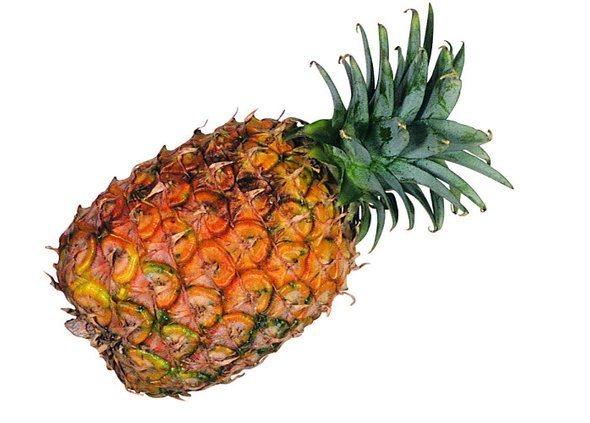(单词翻译:单击)
听力文本
This is Scientific American — 60-Second Science. I'm Debbie Ponchner.
Pineapples—just thinking about this delicious tropical fruit, rich in vitamin C, might make your mouth water. But have you ever stopped to think where the peel and other waste from this crop end up?
We do here in the small country of Costa Rica, the world's largest producer of pineapples. Pineapple production generates about 4.5 million tons of crop residues every year in our Central American nation.
And that waste is tough stuff. The plant is made of strong cellulose that takes a long time to biodegrade. And most of it is either burnt or ends up dumped in open forests, where disease-causing mosquitoes and fungi thrive off its high sugar content.
But hidden in pineapple peels is a treasure—of nanomaterials. Scientists at Costa Rica's National Laboratory of Nanotechnology (LANOTEC) have been extracting valuable nanocellulose from the peel and stubble of the pineapple. This nanocellulose can be used in the pharmaceutical, food and medical industries.
And it turns out that, while harvesting that nanocellulose, you can also get rosettelike silica-based microparticles. These tiny traces have potential as reinforcement in adhesives, in the biomedical field, and even as a source of silica for fertilizers. Scientists from LANOTEC describe these applications in the journal Scientific Reports.

José R. Vega-Baudrit is the director of LANOTEC and one of the authors of the paper. "Pineapple residue is something that has been studied a lot, but nobody had seen this particle in the skin of the fruit."
It was chemical engineer and material scientist Yendry Corrales-Ureña who noticed the silica-based microparticles.
"I began to study the plant, to make the cuts, to see what it had, and incredibly, after doing the synthesis, I began to see those rosettes, like flowers, that did not fall apart under duress. It was wonderful. We had thousands, millions, of the same structures left over."
The pineapple silica differs from silica nanospheres that are synthesized in labs for various applications.
YCU: "This is a silica that the pineapple plant processes on its own, and it is of very high purity."
Most commercial fertilizers use silica. And Corrales-Ureña's main interest in the rosettelike silica-based microparticles is as a fertilizer component. The next steps in that line of research will be to determine if parts other than the peels also have silica nanoparticles, and to develop an efficient fertilizer using them.
Thanks for listening for Scientific American — 60-Second Science. I'm Debbie Ponchner.
参考译文
这里是科学美国人——60秒科学。我是黛比·庞彻纳。
菠萝——只要想想这种富含维生素C的美味热带水果,可能就会让你流口水。但你有没有停下来思考过,这种作物的果皮和其它废料最后到哪里去了?
而在哥斯达黎加这个小国,这个全世界最大的菠萝生产国,我们就在思考这个问题。菠萝种植每年会在我们这个中美洲国家产生约450万吨作物残余。
这些废料是个棘手的难题。菠萝由需要很长时间才能被生物降解的高强度纤维素构成。大部分废料不是被焚烧,就是被丢弃在疏林中——那里的致病蚊子和真菌依靠废料的高糖分生长。
但是,菠萝皮中隐藏着一种名为“纳米材料”的宝藏。哥斯达黎加国家纳米技术实验室(简称LANOTEC)的科学家一直在从菠萝果皮和残株中提取宝贵的纳米纤维素。这种纳米纤维素可用于制药、食品和医疗行业。
结果发现,在获得纳米纤维素的同时,还可以得到玫瑰花状的硅基微粒。这些微粒可能在粘合剂和生物领域起到加固作用,甚至可作为肥料中的二氧化硅来源。纳米技术实验室的科学家在《科学报告》期刊上介绍了这些用途。
何塞·维加-鲍德里特是纳米技术实验室的负责人,也是文章的作者之一。“人们对菠萝残渣进行了大量研究,但是没有人在菠萝果皮中发现过这种颗粒。”
注意到这种硅基微粒的是化学工程师兼材料科学家耶德利·科拉雷斯-包雷尼亚。
“我开始研究这种植物,切开它观察其构造,难以置信的是,在做完合成之后,我开始看到那些没有被迫分解的玫瑰花形状的物质。那真是太奇妙了。我们有了数千甚至是数百万个相同结构的剩余物。”
菠萝二氧化硅不同于在实验室合成的适用于不同用途的二氧化硅纳米球。
耶德利·科拉雷斯-包雷尼亚:“这是菠萝自己加工而成的二氧化硅,纯度非常高。”
大多数商用肥料使用二氧化硅。科拉雷斯-包雷尼亚对于这种玫瑰花形状的硅基微粒的主要兴趣是使其成为一种肥料成分。这一研究方向的下一步计划是,确定菠萝除果皮之外的其余部分是否也含有二氧化硅纳米颗粒,并利用这些颗粒开发出一种高效肥料。
谢谢大家收听科学美国人——60秒科学。我是黛比·庞彻纳。
译文为可可英语翻译,未经授权请勿转载!
重点讲解
重点讲解:
1. be made of (由…)构成的;(由…)制成的;
Some of the internal walls of my house are made of plasterboard.
我家房子的一些内墙是石膏板做的。
2. turn out 原来是;结果发现;
It turned out that I knew the person who got shot.
结果发现我认识那个中枪的人。
3. fall apart 散架;垮掉;摔碎;
The rope bridge breaks in the middle and both halves fall apart.
索桥从中间断了,两头塌了下去。
4. other than 除了…以外;
I don't know any French people other than you.
除了你,我不认识别的法国人。


